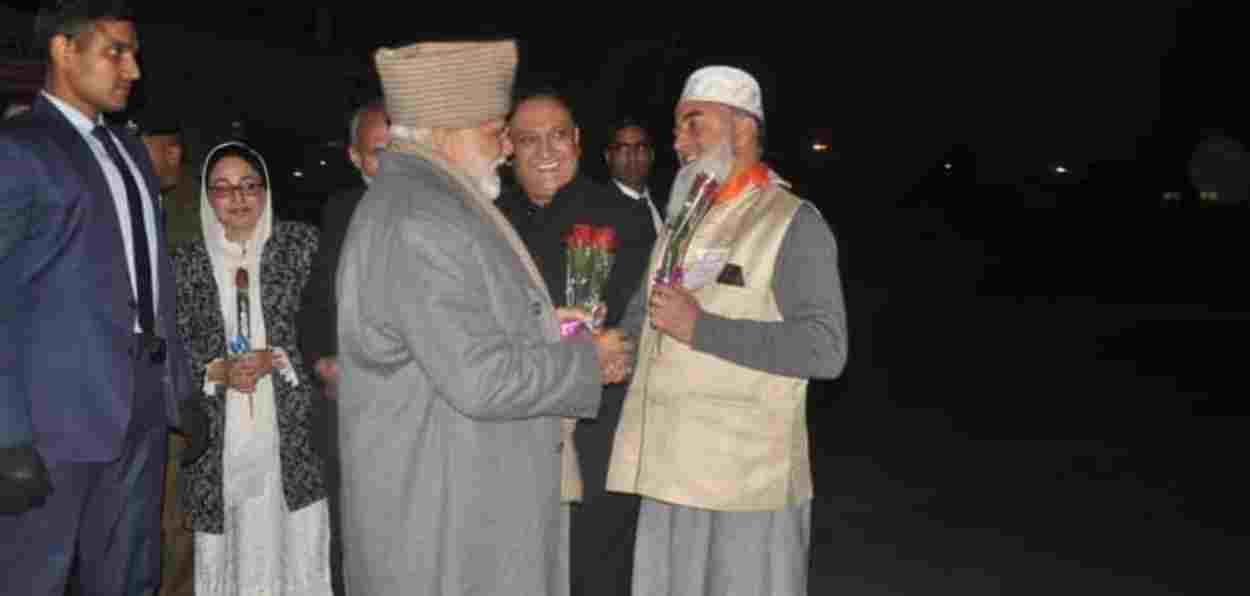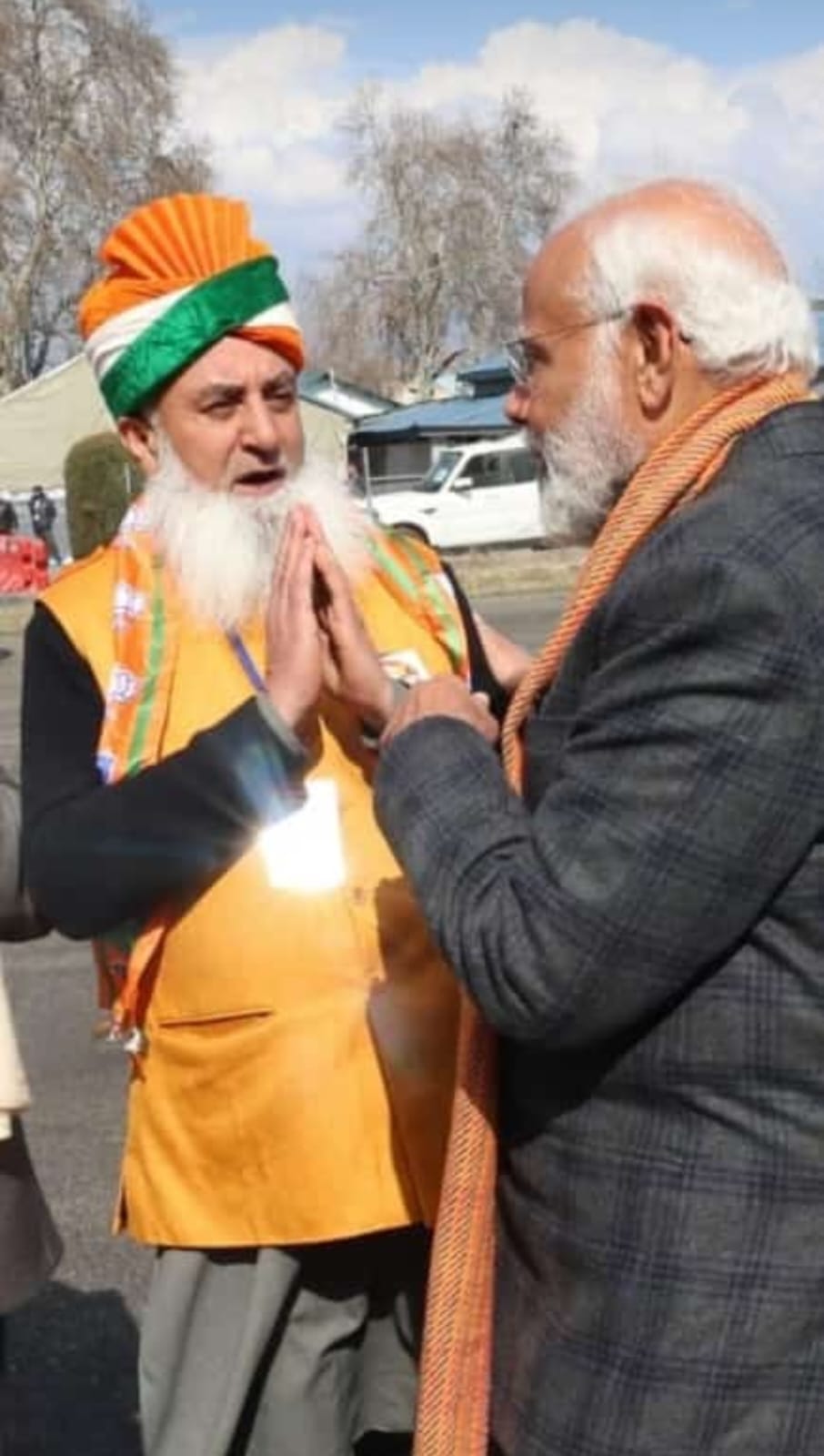
Ahmed Ali Fayyaz/Srinagar
A year after hoisting the national flag at Lal Chowk in Srinagar along with the then BJP President Murli Manohar Joshi amidst threats from terrorists on Republic Day in 1992, Narendra Modi travelled across the length and breadth of the Kashmir valley without security.
The man who hosted and accompanied him - Mohammad Ashraf Hajam aka ‘Azad’ of Hakermulla Budgam - received and saw him off as the Prime Minister of India at the Srinagar airport 32 years later on March 7, 2024.
Azad, who joined the BJP at the age of 24 years and thus qualifies to be called the party’s senior-most worker in Kashmir, has maintained a low profile. He contested the Assembly elections thrice; the Block Development Council (BDC) elections of 2019 and the District Development Council (DDC) elections of 2020 as the BJP candidate. He lost all.
He was also appointed as the BJP’s District President in Budgam for one term.
As PM Modi landed at the Srinagar airport on March 7, he introduced Azad as “my long-time friend.” He enquired about the welfare of his family and also about a developmental project that he is in charge of at Soibugh, the native village of the Pakistan-based Hizbul Mujahideen chief Syed Salahuddin.
 Mohammad Ashraf Hajam greeting Prime Minister Narendra Modi in Srinagar on March 7, 2024
Mohammad Ashraf Hajam greeting Prime Minister Narendra Modi in Srinagar on March 7, 2024
After his rally in Srinagar’s Bakshi Stadium, Prime Minister Modi told Azad that a large number of the Kashmiris had turned up to listen to his speech. “Your hard work has finally borne fruit”, Modi acknowledged. Many of the senior bureaucrats and officers present to receive and see off the Prime Minister were clueless about Azad’s proximity to Modi.
Azad fwas present at Lal Chowk when MM Joshi and Modi hoisted the tricolour just two days after a major explosion at the Police Chief J N Saksena's office in the J&K Police headquarters in Saksena. Six security top guns were injured in the blast.
“I was driven by curiosity; I just wanted to see why the BJP leaders were on a suicidal mission. Many of the militant groups had threatened to kill the BJP leaders. It was the time when bullets and rockets used to rain in Srinagar. Immediately after they hoisted the national flag under the BSF protection, I met Joshi and Modiji. They were happy to see a local youth excited over their act. They carried me along to the Nehru Guest House at Cheshma Shahi. We spoke at length about the valley’s separatist movement and politics”, Azad told ‘Awaz-The Voice’.
Later that year, Joshi and Modi invited Azad to Delhi and introduced him to a large number of senior BJP leaders including Atal Bihari Vajpayee, LK Advani, Pramod Mahajan, Arun Jaitley, Sushma Swaraj and Sikandar Bakht. Most of these meetings were arranged by Modi. Impressed by the party’s agenda, Azad joined the BJP.
“In April 1993, I received a message that Mr Narendra Modi was waiting for me at a government guest house at Sonwar in Srinagar. I went to see him. He received me warmly. After he disclosed his ‘Mission Kashmir’ to me, I hired a taxi for him and brought him to my village. He stayed at my home at Hakermulla, close to the Hizbul Mujahideen chief Salahuddin’s village of Soibugh, for 10 days. While introducing himself as a researcher and human rights activist, he began his interaction with the common people right from Soibugh, the headquarters of Kashmir’s militancy. It was the height of militancy. You could see gunmen roaming on the roads any time of the day and night”, Azad said.
Narendra Modi and Murli Manohar Joshi hoisting the national flag at Lal Chowk, Srinagar (File)
According to Azad, Modi travelled by taxi to about a dozen villages across all six districts of Kashmir. He asked the people about their education, culture, economy, development, and political aspirations and made extensive notes.
Nobody recognised him as a BJP-RSS leader who had hoisted the tricolour at Lalchowk. As such Modi shot into prominence a decade later after he became the Chief Minister of Gujarat.
After Modi returned, Azad stayed in touch with the BJP-RSS leadership and helped them implement their agenda in Kashmir. He was given secure accommodation at the Institute of Management and Public Administration (IMPA) on the Maulana Azad Road where he stayed until 1998. Later, he was shifted to a one-room accommodation at Dalgate. His family stayed put at different places.
Azad’s house at Hakermulla, where Modi stayed, was torched by militants in 1998. Militants also set afire his two other properties at Soibugh. “Years later, I was elected as a Sarpanch of my area. I raised the national flag at Soibugh and involved people in the elections. Last week, residents of Soibugh came in 8 buses to attend Modiji’s rally in Srinagar”, Azad said.
“Raising the Indian flag at Soibugh was more dangerous than raising it at Lal Chowk. I feel lucky that I am still alive”, he added. Five people in his village were killed by militants over the years.
As a political worker, he got a sports stadium, a degree college, a sub-district hospital, and a Police post sanctioned for Soibugh. Besides, he was also behind the construction of a mini stadium and two school buildings at Hakermulla.
“It has been an incredible journey of transformation. Soibugh was for years the control room of militancy and gun culture. Today, youths play nightlong cricket matches there”, Azad said.
People did not know much about Azad till Lok Sabha MP Poonam Mahajan from Mumbai mentioned him in her speech in the Parliament in 2019.
ALSO READ: Danish Rinzu's Biopic on Kashmir’s legendary singer Raj Begum is ready
It/s said that Modi's meticulously worked on Kashmir based on his research during those 10 days and his earlier forays as pracharak of the RSS in Kashmir to find a solution to ending the unrest and turmoil in the Valley.
